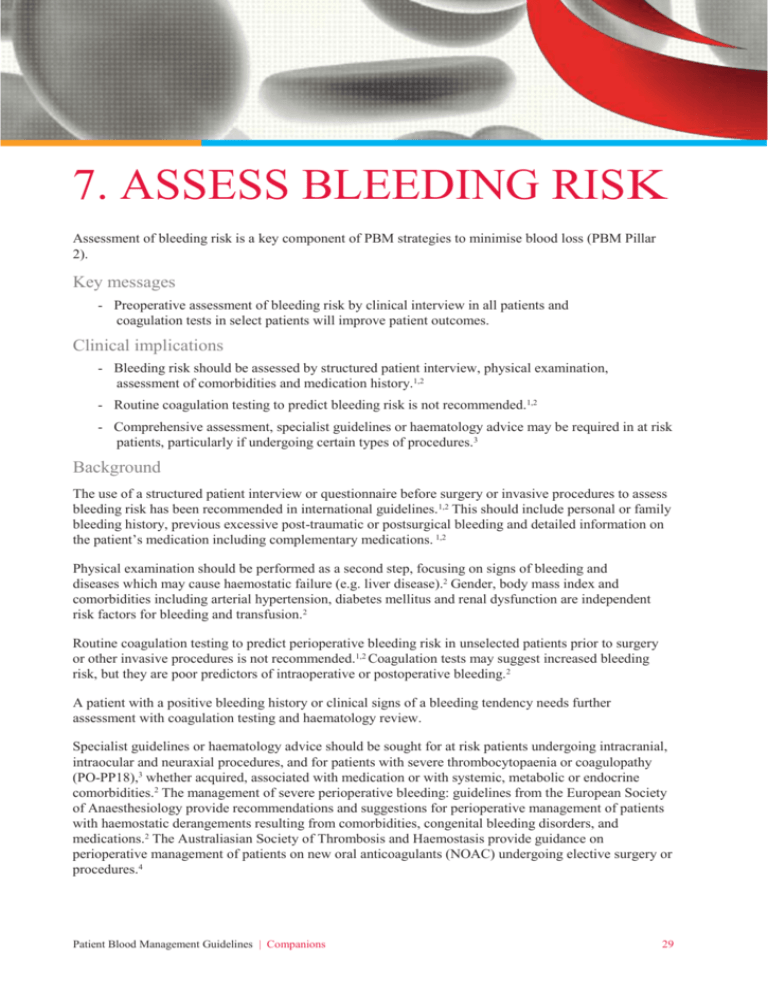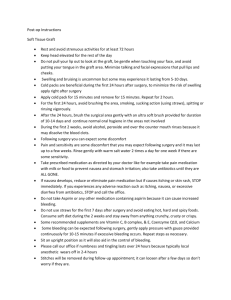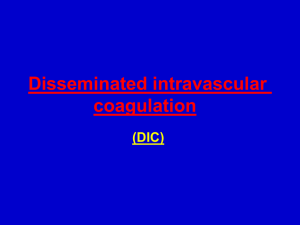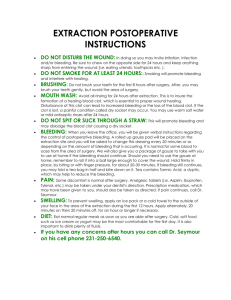Companion 7 PBM Guidelines
advertisement

7. ASSESS BLEEDING RISK Assessment of bleeding risk is a key component of PBM strategies to minimise blood loss (PBM Pillar 2). Key messages - Preoperative assessment of bleeding risk by clinical interview in all patients and coagulation tests in select patients will improve patient outcomes. Clinical implications - Bleeding risk should be assessed by structured patient interview, physical examination, assessment of comorbidities and medication history.1,2 - Routine coagulation testing to predict bleeding risk is not recommended.1,2 - Comprehensive assessment, specialist guidelines or haematology advice may be required in at risk patients, particularly if undergoing certain types of procedures.3 Background The use of a structured patient interview or questionnaire before surgery or invasive procedures to assess bleeding risk has been recommended in international guidelines.1,2 This should include personal or family bleeding history, previous excessive post-traumatic or postsurgical bleeding and detailed information on the patient’s medication including complementary medications. 1,2 Physical examination should be performed as a second step, focusing on signs of bleeding and diseases which may cause haemostatic failure (e.g. liver disease).2 Gender, body mass index and comorbidities including arterial hypertension, diabetes mellitus and renal dysfunction are independent risk factors for bleeding and transfusion.2 Routine coagulation testing to predict perioperative bleeding risk in unselected patients prior to surgery or other invasive procedures is not recommended.1,2 Coagulation tests may suggest increased bleeding risk, but they are poor predictors of intraoperative or postoperative bleeding.2 A patient with a positive bleeding history or clinical signs of a bleeding tendency needs further assessment with coagulation testing and haematology review. Specialist guidelines or haematology advice should be sought for at risk patients undergoing intracranial, intraocular and neuraxial procedures, and for patients with severe thrombocytopaenia or coagulopathy (PO-PP18),3 whether acquired, associated with medication or with systemic, metabolic or endocrine comorbidities.2 The management of severe perioperative bleeding: guidelines from the European Society of Anaesthesiology provide recommendations and suggestions for perioperative management of patients with haemostatic derangements resulting from comorbidities, congenital bleeding disorders, and medications.2 The Australiasian Society of Thrombosis and Haemostasis provide guidance on perioperative management of patients on new oral anticoagulants (NOAC) undergoing elective surgery or procedures.4 Patient Blood Management Guidelines | Companions 29 References 1. Y. L. Chee, J. C. Crawford, H. G. Watson and M. Greaves. Guidelines on the assessment of bleeding risk prior to surgery or invasive procedures. British Committee for Standards in Haematology. British Journal of Haematology, 2008;140:496–504. 2. Kozek-Langenecker SA, Afshari A, Albaladejo P, Santullano CA, De Robertis E, et al. Management of severe perioperative bleeding: guidelines from the European Society of Anaesthesiology. Eur J Anaesthesiol. 2013;30:270382. 3. National Blood Authority. Patient Blood Management Guidelines: Module 2 – Perioperative. Australia, 2012. 4. Tran H, Joseph J, Young L, McRae S, Curnow J, et al. New oral anticoagulants – a practical guide on prescription, laboratory testing and peri-procedural/bleeding management. Internal Medicine Journal, 2014;44:525-536 Additional Resources - 30 Bleeding risk assessment and intervention guide – currently under development by the Blood Service and the NBA Patient Blood Management Guidelines | Companions








